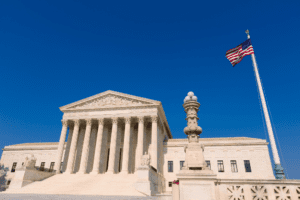 The dissent continued: The Court thinks that the Statute of Northampton “has little bearing on the Second Amendment,” in part because it was “enacted . . . more than 450 years before the ratification of the Constitution.” Ante, at 32. The statute, however, remained in force for hundreds of years, well into the 18th century. See 4 W. Blackstone, Commentaries 148–149 (1769) (“The offence of riding or going armed, with dangerous or unusual weapons, is a crime against the public peace, by terrifying the good people of the land; and is particularly prohibited by the Statute of Northampton” (first emphasis in original, second emphasis added)). It was discussed in the writings of Blackstone, Coke, and others. See ibid.; W. Hawkins, 1 Pleas of the Crown 135 (1716) (Hawkins); E. Coke, The Third Part of the Institutes of the Laws of England 160 (1797). And several American Colonies and States enacted restrictions modeled on the statute. See infra, at 40–42. There is thus every reason to believe that the Framers of the Second Amendment would have considered the Statute of Northampton a significant chapter in the Anglo-American tradition of firearms regulation.
The dissent continued: The Court thinks that the Statute of Northampton “has little bearing on the Second Amendment,” in part because it was “enacted . . . more than 450 years before the ratification of the Constitution.” Ante, at 32. The statute, however, remained in force for hundreds of years, well into the 18th century. See 4 W. Blackstone, Commentaries 148–149 (1769) (“The offence of riding or going armed, with dangerous or unusual weapons, is a crime against the public peace, by terrifying the good people of the land; and is particularly prohibited by the Statute of Northampton” (first emphasis in original, second emphasis added)). It was discussed in the writings of Blackstone, Coke, and others. See ibid.; W. Hawkins, 1 Pleas of the Crown 135 (1716) (Hawkins); E. Coke, The Third Part of the Institutes of the Laws of England 160 (1797). And several American Colonies and States enacted restrictions modeled on the statute. See infra, at 40–42. There is thus every reason to believe that the Framers of the Second Amendment would have considered the Statute of Northampton a significant chapter in the Anglo-American tradition of firearms regulation.
The Court also believes that, by the end of the 17th century, the Statute of Northampton was understood to contain an extratextual intent element: the intent to cause terror in others. Ante, at 34–38, 41. The Court relies on two sources that arguably suggest that view: a 1686 decision, Sir John Knight’s Case, and a 1716 treatise written by Serjeant William Hawkins. Ante, at 34–37. But other sources suggest that carrying arms in public was prohibited because it naturally tended to terrify the people. See, e.g., M. Dalton, The Country Justice 282–283 (1690) (“To wear Armor, or Weapons not usually worn, . . . seems also be a breach, or means of breach of the Peace . . . ; for they strike a fear and terror in the People” (emphasis added)). According to these sources, terror was the natural consequence—not an additional element—of the crime. I find this view more persuasive in large part because it is not entirely clear that the two sources the Court relies on actually support the existence of an intent-to-terrify requirement.
A counter to the dissent’s position is that the right to carry a concealed firearm as opposed to a revealed weapon is at issue. The nature of a “concealed” weapon is that others are unaware of its presence. Other counter points are that 44 states have long permitted the right to carry that is at issue in this case and all 50 states have armed policeman. Mass terror do to the sight of firearms is not a problem under any of those circumstances.
